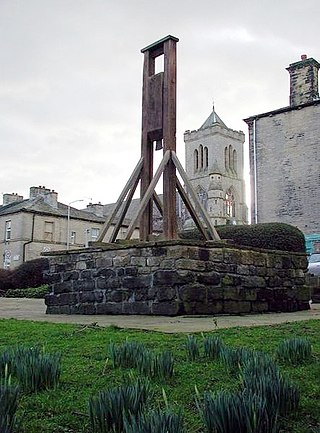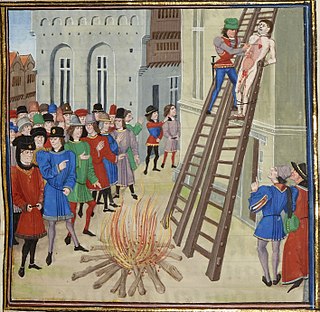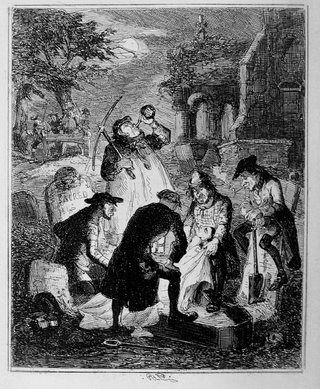Related Research Articles
Posthumous execution is the ritual or ceremonial mutilation of an already dead body as a punishment. It is typically performed to show that even in death, one cannot escape justice.

Crucifixion is a method of capital punishment in which the victim is tied or nailed to a large wooden cross or beam and left to hang until eventual death. It was used as a punishment by the Persians, Carthaginians and Romans, among others. Crucifixion has been used in parts of the world as recently as the 21st century.

Urolagnia associates sexual excitement with the sight or thought of urine or urination, and may also refer to such behaviours or acts. It is a paraphilia.

Decapitation or beheading is the total separation of the head from the body. Such an injury is invariably fatal to humans and most other animals, since it deprives the brain of oxygenated blood, while all other organs are deprived of the involuntary functions that are needed for the body to function.

The breaking wheel or execution wheel, also known as the Wheel of Catherine or simply the Wheel, was a torture method used for public execution primarily in Europe from antiquity through the Middle Ages into the early modern period by breaking the bones of a criminal or bludgeoning them to death. The practice was abolished in Bavaria in 1813 and in the Electorate of Hesse in 1836: the last known execution by the "Wheel" took place in Prussia in 1841. In the Holy Roman Empire it was a "mirror punishment" for highwaymen and street thieves, and was set out in the Sachsenspiegel for murder, and arson that resulted in fatalities.

Burial, also known as interment or inhumation, is a method of final disposition whereby a dead body is placed into the ground, sometimes with objects. This is usually accomplished by excavating a pit or trench, placing the deceased and objects in it, and covering it over. A funeral is a ceremony that accompanies the final disposition. Evidence suggests that some archaic and early modern humans buried their dead. Burial is often seen as indicating respect for the dead. It has been used to prevent the odor of decay, to give family members closure and prevent them from witnessing the decomposition of their loved ones, and in many cultures it has been seen as a necessary step for the deceased to enter the afterlife or to give back to the cycle of life.

The history of anatomy in the 19th century saw anatomists largely finalise and systematise the descriptive human anatomy of the previous century. The discipline also progressed to establish growing sources of knowledge in histology and developmental biology, not only of humans but also of animals.

Capital punishment in the United Kingdom predates the formation of the UK, having been used within the British Isles from ancient times until the second half of the 20th century. The last executions in the United Kingdom were by hanging, and took place in 1964; capital punishment for murder was suspended in 1965 and finally abolished in 1969. Although unused, the death penalty remained a legally defined punishment for certain offences such as treason until it was completely abolished in 1998; the last execution for treason took place in 1946. In 2004 the 13th Protocol to the European Convention on Human Rights became binding on the United Kingdom; it prohibits the restoration of the death penalty as long as the UK is a party to the convention.

A gibbet is any instrument of public execution. Gibbeting is the use of a gallows-type structure from which the dead or dying bodies of criminals were hanged on public display to deter other existing or potential criminals. Occasionally, the gibbet was also used as a method of execution, with the criminal being left to die of exposure, thirst and/or starvation. The practice of placing a criminal on display within a gibbet is also called "hanging in chains".

A gallows is a frame or elevated beam, typically wooden, from which objects can be suspended or "weighed". Gallows were thus widely used to suspend public weighing scales for large and heavy objects such as sacks of grain or minerals, usually positioned in markets or toll gates. The term was also used for a projecting framework from which a ship's anchor might be raised so it is no longer sitting on the seabed, riverbed or dock; "weighing [the] anchor" meant raising it using this apparatus while avoiding striking the ship's hull.

Body snatching is the illicit removal of corpses from graves, morgues, and other burial sites. Body snatching is distinct from the act of grave robbery as grave robbing does not explicitly involve the removal of the corpse, but rather theft from the burial site itself. The term 'body snatching' most commonly refers to the removal and sale of corpses primarily for the purpose of dissection or anatomy lectures in medical schools. The term was coined primarily in regard to cases in the United Kingdom and United States throughout the 17th, 18th, and 19th centuries. However, there have been cases of body snatching in many countries, with the first recorded case dating back to 1319 in Bologna, Italy.

A public execution is a form of capital punishment which "members of the general public may voluntarily attend." This definition excludes the presence of only a small number of witnesses called upon to assure executive accountability. The purpose of such displays has historically been to deter individuals from defying laws or authorities. Attendance at such events was historically encouraged and sometimes even mandatory.

The Halifax Gibbet was an early guillotine used in the town of Halifax, West Yorkshire, England. Estimated to have been installed during the 16th century, it was used as an alternative to beheading by axe or sword. Halifax was once part of the Manor of Wakefield, where ancient custom and law gave the Lord of the Manor the authority to execute summarily by decapitation any thief caught with stolen goods to the value of 131⁄2d or more, or who confessed to having stolen goods of at least that value. Decapitation was a fairly common method of execution in England, but Halifax was unusual in two respects: it employed a guillotine-like machine that appears to have been unique in the country, and it continued to decapitate petty criminals until the mid-17th century.

Necrophilia, also known as necrophilism, necrolagnia, necrocoitus, necrochlesis, and thanatophilia, is sexual attraction or act involving corpses. It is classified as a paraphilia by the World Health Organization (WHO) in its International Classification of Diseases (ICD) diagnostic manual, as well as by the American Psychiatric Association in its Diagnostic and Statistical Manual (DSM).

To be hanged, drawn and quartered became a statutory penalty for men convicted of high treason in the Kingdom of England from 1352 under King Edward III (1327–1377), although similar rituals are recorded during the reign of King Henry III (1216–1272). The convicted traitor was fastened to a hurdle, or wooden panel, and drawn by horse to the place of execution, where he was then hanged, emasculated, disembowelled, beheaded, and quartered. His remains would then often be displayed in prominent places across the country, such as London Bridge, to serve as a warning of the fate of traitors. For reasons of public decency, women convicted of high treason were instead burned at the stake.

The practice of human trophy collecting involves the acquisition of human body parts as trophy, usually as war trophy. The intent may be to demonstrate dominance over the deceased, to humiliate or intimidate the enemy, or in some rare cases to commemorate the deceased. It can be done to prove one's body count in battle, to boast one's prowess and achievements to peers, or as a status symbol of superior masculinity. Serial killers' collection of their victims' body parts have also been described as a form of trophy-taking.
An anatomy murder is a murder committed in order to use all or part of the cadaver for medical research or teaching. It is not a medicine murder because the body parts are not believed to have any medicinal use in themselves. The motive for the murder is created by the demand for cadavers for dissection, and the opportunity to learn anatomy and physiology as a result of the dissection. Rumors concerning the prevalence of anatomy murders are associated with the rise in demand for cadavers in research and teaching produced by the Scientific Revolution. During the 19th century, the sensational serial murders associated with Burke and Hare and the London Burkers led to legislation which provided scientists and medical schools with legal ways of obtaining cadavers. Rumors persist that anatomy murders are carried out wherever there is a high demand for cadavers. These rumors, like those concerning organ theft, are hard to substantiate, and may reflect continued, deep-held fears of the use of cadavers as commodities.

A drowning pit, drowning pool, murder-pool or murder hole was a well or pond specifically for executing women and girls under Scottish feudal laws. Rivers or lochans were used if conveniently situated near to a moot hill, where the baronial court dempster would announce the death penalty. The term fossa was also used, as in the phrase ‘furca and fossa’.

Resurrectionists were body snatchers who were commonly employed by anatomists in the United Kingdom during the 18th and 19th centuries to exhume the bodies of the recently dead. Between 1506 and 1752 only a very few cadavers were available each year for anatomical research. The supply was increased when, in an attempt to intensify the deterrent effect of the death penalty, Parliament passed the Murder Act 1752. By allowing judges to substitute the public display of executed criminals with dissection, the new law significantly increased the number of bodies anatomists could legally access. This proved insufficient to meet the needs of the hospitals and teaching centres that opened during the 18th century. Corpses and their component parts became a commodity, but although the practice of disinterment was hated by the general public, bodies were not legally anyone's property. The resurrectionists therefore operated in a legal grey area.

Desecration of graves involves intentional acts of vandalism, theft or destruction in places where humans are interred: this includes body snatching. It has long been considered taboo to desecrate or otherwise violate graves or grave markers of the deceased, and in modern times it has been prohibited by law. Desecration is defined as violating something that is sacred.
References
- ↑ One or more of the preceding sentences incorporates text from a publication now in the public domain : Chisholm, Hugh, ed. (1911). "Body-Snatching". Encyclopædia Britannica . Vol. 4 (11th ed.). Cambridge University Press. p. 112.
- ↑ Omissi, Adrastos (28 June 2018). Emperors and Usurpers in the Later Roman Empire: Civil War, Panegyric, and the Construction of Legitimacy. OUP Oxford. p. 36. ISBN 978-0-19-255827-5. Archived from the original on 7 November 2021. Retrieved 6 December 2021.
- ↑ Pettifer, Ernest (1992). Punishments of Former Days. Winchester: Waterside Press. p. 83. ISBN 978-1-8-72870-05-2.
- ↑ Harold Schechter; David Everitt (4 July 2006). The A to Z Encyclopedia of Serial Killers. Simon and Schuster. p. 290. ISBN 978-1-4165-2174-7. Archived from the original on 7 January 2014. Retrieved 27 January 2011.
- ↑ Goodwin, Robin; Cranmer, Duncan, eds. (2002). Inappropriate Relationships: The Unconventional, the Disapproved, and the Forbidden. London, England: Psychology Press. pp. 174–176. ISBN 978-0805837421.
- ↑ Gantt, Darin (24 July 2014). "Modell family wants to press charges against grave urinator". Pro football Talk. Archived from the original on 6 December 2021. Retrieved 6 December 2021.